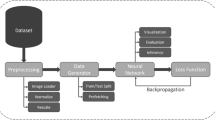Abstract
This paper presents an adaptive denoising approach aiming to improve the visibility and detectability of hemorrhage from brain computed tomography (CT) images. The suggested approach fuses the images denoised by total variation (TV) method, denoised by curvelet-based method, and edge information extracted from the noise residue of TV method. The edge information is extracted from the noise residue of TV method by processing it through curvelet transform. The visual interpretation shows that the proposed approach not only reduces the staircase effect caused by total variation method but also reduces visual distortion induced by curvelet transform in the homogeneous areas of the CT images. The denoising abilities of the proposed method are further evaluated by segmenting the hemorrhagic brain area using region-growing method. The sensitivity, specificity, Jaccard index, and Dice coefficients were calculated for different noise levels. The comparative results show that the significant improvement has yielded in the brain hemorrhage detection from CT images after denoising it with the proposed approach.






Similar content being viewed by others
References
Cohen W, Wayman L: Computed tomography of intracranial hemorrhage. Neuro Imaging Clin N Am 2:75–87, 1992
Gravel P, Beaudoin G, De Guise JA: A method for modeling noise in medical images. IEEE Trans Med Imaging 23(10):1221–1232, 2004
Lei T, Sewchand W: Statistical approach to X-ray CT imaging and its applications in image analysis—part I: statistical analysis of X-ray CT imaging. IEEE Trans Med Imaging 11(1):53–61, 1992
Lee JS: Digital image enhancement and noise filtering by using local statistics. IEEE Trans Pattern Anal Mach Intell, PAMI 2(2):165–168, 1980
Perona P, Malik J: Scale-space and edge detection using anisotropic diffusion. IEEE Trans Pattern Anal Mach Intell 12(7):629–639, 1990
Rudin LI, Osher S, Fatemi E: Nonlinear total variation based noise removal algorithms. Phys D 60:259–268, 1992
Chambolle A: An algorithm for total variation minimization and applications. J Math Imaging Vision 20:89–97, 2004
Donoho DL: Denoising by soft thresholding. IEEE Trans Inf Theory 41:613–627, 1995
Rabbani H, Nezafat R, Gazor S: Wavelet domain medical image denoising using bivariate Laplacian mixture model. IEEE Trans Biomed Eng 56(12):2826–2837, 2009
Borsdorf A, Raupach R, Flohr T, Hornegger J: Wavelet based noise reduction in CT images using correlation analysis. IEEE Trans Med Imaging 27(12):1685–1703, 2008
Ali SA, Vathsal S, Kishore KL: Efficient denoising technique for CT Images using Window based multi-wavelet transformation and thresholding. Eur J Sci Res 48(2):315–325, 2010
Donoho DL, Duncan MR: Digital curvelet transform: strategy, implementation and experiments. Standford University, 1999
Starck JL, Candes EJ, Donoho DL: The curvelet transform for image denoising. IEEE Trans Image Proc 11(6):670–684, 2002
Starck JL, Murtagh F, Candes EJ, Donoho DL: Gray and color image contrast enhancement by the curvelet transform. IEEE Trans Image Proc 12(6):706–717, 2003
Candes EJ, Demanet L, Donoho DL, Ying L: Fast discrete curvelet transforms. 2005 http://www.curvelet.org.papers.FDCT.pdf
Aili W, Zhang Y, Shaoliang M, Mingji Y: Image denoising method based on curvelet transform. 3rd IEEE Conf Ind Electron Appl 571–574, 2008
Bhadauria HS, Dewal ML, Anand RS: Comparative analysis of curvelet based techniques for denoising of computed tomography images. IEEE Int Conf Devices Commun (ICDeCom) 1–5, 2011
Bhadauria HS, Dewal ML: Performance evaluation of curvelet and wavelet based denoising methods on brain computed tomography images. IEEE Int Conf Emerg Trends Electr Comput Technol (ICETECT) 666–670, 2011
Holshneider M, Kronland-Martinet R, Morlet J, Tchamitchian P (1989) A real-time algorithm for signal analysis with the help of the wavelet transform. In: Wavelet, time–frequency methods and phase space. Springer: New York 389–297, 1989
Shensa MJ: The discrete wavelet transform: wedding the à trous and mallat algorithms. IEEE Trans Signal Proc 40(10):2464–2482, 1992
Deans SR: The radon transform and some of its application. Wiley, New York, 1983
Nason GP, Silverman BW: The stationary wavelet transform and some statistical applications. Lecture notes in statistics 103, wavelets and statistics. Springer: New York 281–299, 1995
Li H, Wang S, Deng C: New image denoising method based on wavelet and curvelet transform. IEEE Conf Proc ICIE 136–139, 2009
Metz C: Basic principles of ROC analysis. Semin Nucl Med 8:283–298, 1978
Zaki WMDW, Fauzi MFA, Bessar R, Ahamad SHWM: Abnormalities detection in serial computed tomography brain images using multi-level segmentation approach. J Multimedia Tools Appl, 2010. doi:10.1007/s11042-010-0524-0. Springer
Author information
Authors and Affiliations
Corresponding author
Rights and permissions
About this article
Cite this article
Bhadauria, H.S., Dewal, M.L. Efficient Denoising Technique for CT images to Enhance Brain Hemorrhage Segmentation. J Digit Imaging 25, 782–791 (2012). https://doi.org/10.1007/s10278-012-9453-y
Published:
Issue Date:
DOI: https://doi.org/10.1007/s10278-012-9453-y




